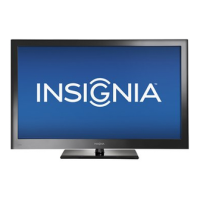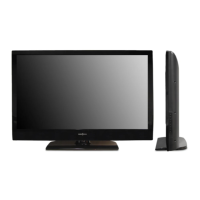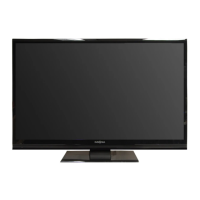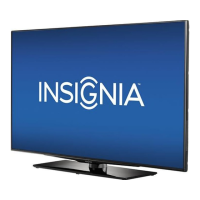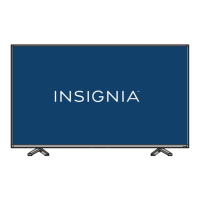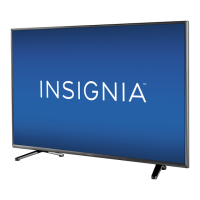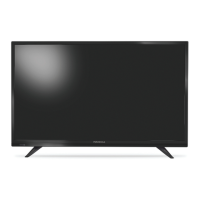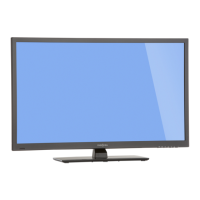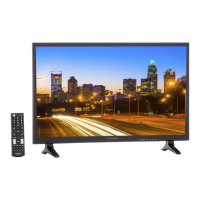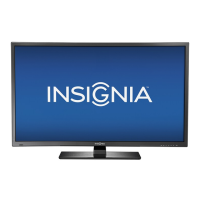Do you have a question about the Insignia NS-55D420NA16 and is the answer not in the manual?
Discusses safe placement of TVs to prevent injury from tipping.
Warns about electric shock hazards and lightning protection.
Provides caution regarding handling the LCD panel to prevent injury.
Explains connecting MHL-enabled devices to view content on the TV.
Details compatibility with Roku Streaming Stick for streaming services.
Describes INlink for controlling HDMI CEC devices with the TV remote.
Highlights DTS Sound for enhanced audio quality.
Explains using Game Mode to optimize TV settings for video games.
Step-by-step guide for attaching the TV stand to the television.
Provides crucial warnings for securely attaching the TV to a wall mount.
Lists all items included in the TV package.
Identifies and describes the buttons on the front of the TV.
Identifies and describes the buttons located on the right side of the TV.
Details the function and connection options for ports on the left side.
Explains the purpose and usage of ports located on the back of the TV.
Lists each button and its corresponding function on the remote.
Identifies various connection types and their corresponding cables.
Step-by-step instructions for connecting a cable/satellite box using HDMI.
Important note about shared jacks for component and AV connections.
Important note about shared jacks for AV and component connections.
Provides tips for using coaxial cables to reduce interference.
Offers advice on improving picture quality with antenna or cable connections.
Instructions for connecting a DVD or Blu-ray player using HDMI.
Important note about shared jacks for component and AV connections.
Important note about shared jacks for AV and component connections.
Specific notes about using the HDMI2(MHL) jack for Roku connection.
Specific notes about using the HDMI2(MHL) jack for MHL devices.
Instructions for connecting a game console using HDMI.
Important notes on component video connections for game consoles.
Important notes on AV (composite video) connections for game consoles.
Instructions for connecting a computer to the TV using HDMI.
Warning about safely removing USB drives and potential data loss.
Warns about potential hearing damage from loud headphone volume.
Steps for connecting speakers using a digital optical audio cable.
Steps for connecting speakers using an analog audio cable.
General guidance on connecting multiple devices to a home theater system.
Important caution regarding operating the TV from the correct power source.
Step-by-step instructions for inserting batteries into the remote.
Guidance on how to properly aim the remote control at the TV sensor.
Instructions on how to find and view remote control codes in the TV menu.
Guides the user through the initial TV setup process.
Explains how to power the TV on and off, including standby mode.
Describes how to choose the active input source for connected devices.
Explains the structure and navigation of the TV's on-screen menus.
Details methods for changing channels, including number input and favorites.
Explains how to increase, decrease, or mute the TV volume.
Describes how to display information about the current program and channel.
Steps to connect and begin using the Roku Streaming Stick.
Explains how to connect and use MHL devices like smartphones.
Details how to enable and use the INlink feature for device control.
Configures the TV to turn on automatically with connected HDMI CEC devices.
Configures devices to turn off automatically when the TV is turned off.
Shows how to view a list of HDMI CEC devices connected to the TV.
Explains how to access and control a device's root menu using the TV remote.
Steps to switch the TV input to USB mode to access connected drives.
Instructions on how to browse JPEG photos stored on a USB flash drive.
How to add photos to a favorite list for quick access.
Guide to adjusting various picture settings for optimal viewing.
Details how to adjust settings like Picture Mode, Brightness, Contrast, and Color.
Explains various aspect ratio settings like Normal, Zoom, Wide, Cinema, and Auto.
Covers adjusting sound settings and selecting audio output modes.
Options for managing TV speaker output when connecting external audio devices.
Settings for digital audio output and synchronizing audio with video.
Explains how to select audio output modes like Variable or Fixed.
Options for managing channels, including scanning and favorites.
Steps to scan for available TV channels and store them.
Guide to creating and managing a list of favorite channels for quick access.
Instructions for adding or modifying custom labels for TV channels.
How to check signal strength for optimizing antenna or cable connections.
Steps to set or change the password for parental control features.
How to set rating levels for blocking TV programs based on content.
Details for setting parental locks for U.S. movie and TV ratings.
Details for setting parental locks for Canadian English and French ratings.
How to disable physical buttons on the TV using the remote control.
Instructions to enable or disable closed captioning display.
Options to customize the appearance and behavior of digital closed captions.
Guide to setting the TV's date, time, and time zone.
Options for customizing the TV's on-screen menu language and input sensing.
How to add custom labels to input sources for easier identification.
Instructions for cleaning the exterior of the TV cabinet.
Instructions for cleaning the TV screen safely.
How to access system information for troubleshooting purposes.
Accessing help and additional information about the TV's features.
Steps to update the TV's firmware using a USB flash drive.
Instructions to reset all TV settings to their factory defaults.
Solutions for common picture display issues like aspect ratio and no picture.
Solutions for common audio issues like no sound or poor sound quality.
Covers various general TV issues like no power, input selection, and channel reception.
Lists the video and audio output capabilities of the TV.
Details screen size, type, resolution, refresh rate, and panel specifications.
Lists supported input types like HDMI, Component, Composite, USB, and Antenna.
Information regarding the device's compliance with FCC regulations.
Compliance information specific to Canadian standards.
Compliance information regarding Industry Canada license-exempt RSS standards.
Defines key terms used within the warranty statement.
Specifies the duration and start date of the warranty.
Lists the conditions and parts covered by the Insignia warranty.
Provides contact information and procedures for claiming warranty service.
Identifies the geographical areas where the warranty is applicable.
Lists items and conditions explicitly excluded from warranty coverage.
Solutions for when the TV does not display video from a CEC device.
Solutions for when the TV does not play audio from a CEC device.
Lists the video and audio output capabilities of the TV.
Details audio features like DTS tuning package and speaker power.
Information on power consumption and input requirements.
Covers OSD languages, INlink, Roku Ready, Game Mode, and VESA mount details.
Acknowledges Dolby licensing and trademarks used in the product.
Information regarding HDMI trademarks and licensing.
Acknowledges DTS Sound patents and trademarks.
Information regarding MHL trademarks and licensing.
Information regarding Roku trademarks and licensing.
Details about the open-source font and license used in the TV.
Defines key terms used within the warranty statement.
Specifies the duration and start date of the warranty.
Lists the conditions and parts covered by the Insignia warranty.
Provides contact information and procedures for claiming warranty service.
Identifies the geographical areas where the warranty is applicable.
Lists items and conditions explicitly excluded from warranty coverage.
| Screen Size | 55 inches |
|---|---|
| Resolution | 1920 x 1080 |
| Display Type | LED |
| Refresh Rate | 60Hz |
| HDMI Ports | 3 |
| USB Ports | 1 |
| Smart TV Platform | Fire TV |
| Built-in Wi-Fi | Yes |
| Audio Output | 20W |
